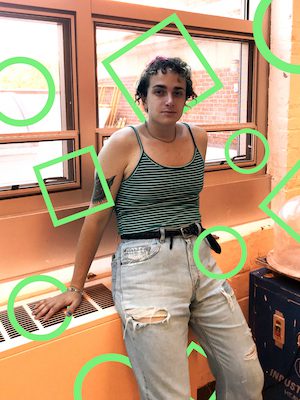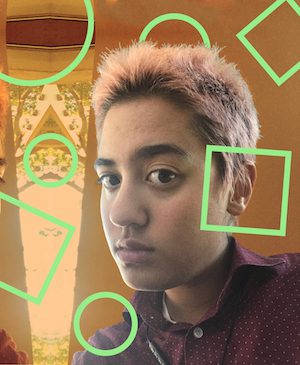 (Visual by Marjerrie Masicat)
(Visual by Marjerrie Masicat)
As a nonbinary person, my relationship with gender has shifted throughout my life. It hasn’t been a linear progression from one end of the gender binary to another, and I have experimented with my outward presentation and pronouns along the way. My gender does not have a definitive endpoint. It won’t reach its culmination when I can “pass” as either a boy or a girl. On the contrary, my ideal existence would be pretty devoid of gendered expectations altogether, because I’m good at failing them anyway.
In a heteronormative and patriarchal society, expressing queer identity is a form of resistance. It can empower us to confront internalized and external transphobia, and it can also put us in danger that is both physical and psychological. I spoke with six people who identify as trans, nonbinary and/or genderqueer about their experiences with being visibly queer in public, how social expectations impact their decisions about gender expression, and the messiness of living outside the binary.
Alex McDermott
Oakland, CA
He/Him | @homogoods

“I am like a gender chameleon. I can shift and morph and make myself feel good in any situation,” said Alex, who identifies as gender-fluid. He doesn’t align with either end of the female-male binary.
Alex began identifying publicly as trans in high school. “I was like ‘Okay, I’m trans, therefore I am a man now, therefore I am going to look at all of these cis-men around me and strive to look and be like these men.’ I felt like folks around me would be more willing to accept me as a trans person if at least I was still adhering to the binary in some sense.”
Alex told me this was partially a result of internalized transphobia. As transgender narratives become increasingly mainstream, there is still a sense that expressing gender as neatly feminine or masculine makes it more palatable, and safer. Within this limited framework, the journey of gender reaches its successful conclusion only when a person has transitioned from one gender to another. Alex was concerned about others’ reactions to a less legible expression of gender.
“Finding a community and seeing other folks existing in the world in this fluid, nonconforming way, [I realized] heads aren’t going to implode if I express myself the way I express myself. I do feel good in shorts, and I do feel good in a dress and all of those things are true to me.”
But some days Alex won’t choose to wear the dress. “There are spaces for me that feel really comfortable and there are spaces that don’t feel comfortable and it’s ok, it’s self-care, to be aware of that difference.”
Romi Lumen
New York, New York
They/ Them | @transcndental

“My gender is informed by my sexuality, which informs the way I navigate the world. They aren’t interchangeable, but they both play a part in my experience. My femininity was predicated on the idea that I had to assume a certain gender expression to ‘get a man.’
Knowing that I had little to no romantic attraction to cis men allowed me to finally stop dressing in ways that could provoke desire from them. It felt, on the one hand, liberating and, on the other, stifling. I felt like if I showed too much skin, I was allowing myself to be objectified.
I had to take some hard looks at what black womanhood means, how I fit in as a nonbinary dyke, and how that translates in my essence. My expression of femininity does not mean womanhood. My expression of masculinity does not mean I am in binary transition. I am floating, consciously, in a space that suits my needs and understanding of myself.”
Aidan Huntington
Somerville, MA
They/Them | @aerhuntington

Aidan says that they feel the most comfortable presenting as “futch,” meaning their style is a mix of femme and butch.
“I identify as nonbinary. But I don’t necessarily always feel totally aligned with what that identity entails for other people. In terms of experience and understanding of my gender, a lot of times I feel more aligned with trans girls and women. I would say I’m like ‘girl adjacent’ but still nonbinary. The days that I feel the best are the days when I know what I want to wear and I put it on and it feels like it matches me.”
When Aidan can “match” their gender identity with their expression, their gender dysphoria, a heightened sense that their gender and their physical body are at odds, subsides.
“It’s hard to know how much of dysphoria is internal and how much is based on the standards of a transphobic world. A lot of it comes when I can’t convince myself that I look the way that I think and want to look. When all of a sudden I am more aware in an outfit that it makes my shoulders look really broad, or other things like that are dysphoric cues.
Even though I am not shooting for being a capital W ‘Woman,’ for me at least I want some strangers on the street to think that I am. Even though I am not necessarily fully identifying as a woman, that doesn’t do away with aspirations of being aligned with womanhood.”
Chuck Bernsohn
Chicago, IL
They/Them | @cbernsohn

Chuck leads workplace trans-inclusive gender equity training. As a person who identifies as nonbinary and genderqueer, Chuck’s work is directly tied to their life experiences.
“Something I talk a lot about in my workshops is this disconnect between gender identity and gender presentation. You can’t look at somebody and determine their gender, or their pronouns, or anything about them beyond what they physically look like to you.
I think that part of nonbinary identity for me is kind of ‘riding the waves’ a little bit, and it’s so freeing. I identify as masculine-of-center in terms of the way that I present gender. I wear button-downs. I wear them all the time. I haven’t worn a skirt or a dress in probably a decade.
Being misgendered as a man is much more comfortable than being misgendered as a woman, and I think that presenting masculinely is a really nice way to try to swing things in that direction. I am also a person who 100 percent believes that gender norms are socially constructed. At some point, defining myself by a binary system doesn’t necessarily help me figure anything else out.”
Olivia Caro
Philadelphia, PA
They/Them | @oblivia.c

Olivia is an art teacher and working artist in Philadelphia. They said that when they initially started identifying as nonbinary, they were concerned with how their style influenced others’ perceptions of their gender identity.
“When I first started identifying as genderqueer/nonbinary and started using they/them pronouns, I put more pressure on myself to look a certain way to fit into that category. But if I am not giving a fuck about what other people think… I don’t have to not wear something because it’s ‘too feminine.’
One Christmas my sister got me this glitter nail polish and these fun print boxers and I was like, ‘Wow this is excellent.’ I feel the most comfortable when I kind of have a balance. I have no problem wearing crop tops and more feminine shirts or more fitted shorts. But I won’t usually wear them together.
If I can wear a pair of jeans and a button-down tucked in, I am very comfortable in that. And I will switch it up between a men’s buttondown or my women’s light pink button-down that I got from the thrift store that’s very femme. I am very comfortable in both.”
Marley
Somerville
They/Them

“I have pretty consistently identified as nonbinary. Whether I call myself trans or not kind of depends,” said Tufts University student and activist Marley, who told me their gender identity doesn’t always perfectly align with their expression or pronouns.
“I struggle with the trans label because a lot of times people hear trans and they think ‘binary trans’ and medical transitions and things like that. And at this point in time, I’m neither of those.
I went through a pretty aggressively femme phase during freshman year of college. I was like ‘I really just want to fit in and be accepted.’ Over the years I have swung towards more butch or more masc. Eventually, I hit a wall and was like I don’t care what other people want from me, I just want to be comfortable.
As much as I would like to just have it be ‘this is who I am and that’s it, end of story,’ a lot of gender is how other people perceive you. It should be a fill-in-the-blank but it’s boxes.”